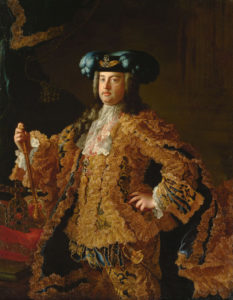
Whether we choose to like her or dislike her (not that she would have cared a whit one way or the other), Maria Theresa Walburga Amalia Christina, Habsburg Empress and German Queen was a remarkable person. She was the only woman to ever rule the Habsburg Empire (for 40 years; from 1740 until her death in 1780), the absolute sovereign of Austria, Hungary, Bohemia, Croatia, Transylvania; Lodomeria and Galicia (in present day Poland and Ukraine); the Austrian Netherlands; and the duchies of Milan, Mantua, and Parma (in present day Italy).
She was born on May 13, 1717, the oldest surviving child of the Holy Roman Emperor Charles VI. In January of 1737, the not-quite 20-year-old Maria Theresa was married to Francis Stephen, the Grand Duke of Tuscany.
Maria Theresa’s father, Charles VI died on October 20, 1740 at the age of 55, poisoned by a mushroom. Despite the fact that she was slated to succeed her father, very little had been done to prepare her to rule; rather, it was assumed that on her ascension she would be a royal figurehead and that the actual business of ruling the empire would fall to her father’s ministers and to her husband.
Wrong on all counts.
Maria Theresa might not have been taught the matters of state, but was smart, savvy, and ambitious and she learned – very quickly – on the job.
She inherited an empire in disarray. Writing in 1750, ten years into her reign, Maria Theresa recalled in her Political Testament the circumstances under which she had ascended:
“I found myself without money, without credit, without an army, without experience and knowledge of my own and finally, also without any counsel because each one of them [her father’s ministers] at first wanted to wait and see how things would develop.”
Thinking that a “weak, inexperienced woman” had ascended to the crown of Austria, the vultures flew in for the kill: France drew up a plan to divvy up Austrian lands between Prussia, Bavaria, Saxony and Spain. The resulting conflict is known today as the “War of Austrian Succession.”
It was a complete miscalculation on the part of France, Prussia, Bavaria, Saxony and Spain. As head-of-state, the young Maria Theresa proved eminently capable of mounting a robust military response and in making the sorts of alliances necessary to beat back Austria’s enemies.
Even as the 23/24-year-old Maria Theresa was engaged with the war, she was consolidating her power at home. As a woman, she could not be elected “Holy Roman Emperor” (or “Empress”, for that matter), a position left empty at the death of her father. The only way she could become the Holy Roman Empress was if her husband, Francis Stephen, was first elected Holy Roman Emperor. But Francis did not possess the requisite land or rank to make him eligible for the imperial throne. So on November 21, 1740, Maria Theresa made her husband co-ruler of Austria and Bohemia. Intense politicking followed, and Francis was eventually elected Holy Roman Emperor as Francis I, making Maria Theresa the Holy Roman Empress. But Francis was never allowed to forget who wore the pantaloons in the royal family, and his titles meant nothing: he was never allowed to decide matters of state. If he had the temerity to disagree with her in council meetings, Maria Theresa was wont to dismiss him.

When Joseph’s father Francis I died in 1765, he inherited his father’s titles: Holy Roman Emperor and co-ruler with his mother of Austria and Bohemia. But, in fact, he had no more authority than had his father, and more than once he threatened to resign as co-regent when Maria Theresa refused his council.
Maria Theresa finally kicked the scepter on November 29, 1780, and Joseph hit the ground running. Over the course of the next ten years, in his desire to create a more paternal, more benevolent society, he issued over 6,000 edicts and introduced over 11,000 new laws. He directed the government to alter its course and instituted a policy of “enlightened despotism” that sought to enhance “the good of all.” He made elementary education compulsory for all boys and girls of all social classes. He reorganized the legal system with an eye to “justice for all” and restructured and simplified the tax code. He sought to reign in the power of the church (and thus promote the power of the state!) by secularizing church lands and reducing the power of the clergy. Joseph’s “Patent of Toleration” of 1781 guaranteed freedom of worship for non-Catholic Christian denominations; his “Edict of Tolerance” of 1782 did away with many of the regulatory restrictions placed on Jews. He abolished serfdom in 1781 and the death penalty in 1789 (both of which were, sadly, reinstated after his death). He removed restrictions on trade and significantly reduced government censorship.…
Continue reading, only on Patreon!
Become a Patron!